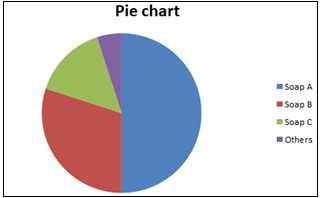
A survey was conducted to study the various brands of soaps used by people in a village.
Brand of soap A B C Others Percent of Villagers $50\% $ $30\% $ $15\% $ $5\% $
Draw Pie Chart of given data.
| Brand of soap | A | B | C | Others |
| Percent of Villagers | $50\% $ | $30\% $ | $15\% $ | $5\% $ |
Answer
560.1k+ views
Hint: From the question, we have to draw a pie chart. First, we are going to calculate the portions of the pie chart that is to be represented. Here, the percentage of villagers using brand of soaps are given. After calculating the degrees in the pie chart, we will plot them.
Formula used: We will transfer each percentage in terms of degrees as a pie chart is of ${360^ \circ }$ in total.
So, any ${\text{soap usage}}$ = ${\text{percentage}}$ $\times$ ${360^ \circ }$
Complete step-by-step solution:
Now, we are going to find out the portions of the villagers that use a particular brand of soap.
From the given information,
Portion of villagers who use soap A= \[50\% \times {360^ \circ }\]
We calculate the percentage in terms of degree, by dividing the percentage term with 100= $\dfrac{{50}}{{100}} \times {360^ \circ }$
The proportion obtained is = ${180^ \circ }$
Portion of villagers who use soap B= $30\% \times {360^ \circ }$
We calculate the percentage in terms of degree, by dividing the percentage term with 100=$\dfrac{{30}}{{100}} \times {360^ \circ }$
The proportion obtained is =${108^ \circ }$
Portion of villagers who use soap C= $15\% \times {360^ \circ }$
We calculate the percentage in terms of degree, by dividing the percentage term with 100= $\dfrac{{15}}{{100}} \times {360^ \circ }$
The proportion obtained is = ${54^ \circ }$
Portion of villagers who use others= $5\% \times {360^ \circ }$
We calculate the percentage in terms of degree, by dividing the percentage term with 100= $\dfrac{5}{{100}} \times {360^ \circ }$
The proportion obtained is =${18^ \circ }$
We need to draw a pie chart representing the usage of soaps of the villagers with the calculated degrees.

This is the pie chart for the given data. Here, the colours represent the particular soaps and the portions represent their proportions.
Note: A pie chart is used to represent the dataset in a graphical view. It is very easy to understand with a single glance at it. It shows the relative proportions of multiple datasets. It helps to summarize a large data set in a pictorial view.
Formula used: We will transfer each percentage in terms of degrees as a pie chart is of ${360^ \circ }$ in total.
So, any ${\text{soap usage}}$ = ${\text{percentage}}$ $\times$ ${360^ \circ }$
Complete step-by-step solution:
Now, we are going to find out the portions of the villagers that use a particular brand of soap.
From the given information,
Portion of villagers who use soap A= \[50\% \times {360^ \circ }\]
We calculate the percentage in terms of degree, by dividing the percentage term with 100= $\dfrac{{50}}{{100}} \times {360^ \circ }$
The proportion obtained is = ${180^ \circ }$
Portion of villagers who use soap B= $30\% \times {360^ \circ }$
We calculate the percentage in terms of degree, by dividing the percentage term with 100=$\dfrac{{30}}{{100}} \times {360^ \circ }$
The proportion obtained is =${108^ \circ }$
Portion of villagers who use soap C= $15\% \times {360^ \circ }$
We calculate the percentage in terms of degree, by dividing the percentage term with 100= $\dfrac{{15}}{{100}} \times {360^ \circ }$
The proportion obtained is = ${54^ \circ }$
Portion of villagers who use others= $5\% \times {360^ \circ }$
We calculate the percentage in terms of degree, by dividing the percentage term with 100= $\dfrac{5}{{100}} \times {360^ \circ }$
The proportion obtained is =${18^ \circ }$
We need to draw a pie chart representing the usage of soaps of the villagers with the calculated degrees.

This is the pie chart for the given data. Here, the colours represent the particular soaps and the portions represent their proportions.
Note: A pie chart is used to represent the dataset in a graphical view. It is very easy to understand with a single glance at it. It shows the relative proportions of multiple datasets. It helps to summarize a large data set in a pictorial view.
Recently Updated Pages
Why are manures considered better than fertilizers class 11 biology CBSE

Find the coordinates of the midpoint of the line segment class 11 maths CBSE

Distinguish between static friction limiting friction class 11 physics CBSE

The Chairman of the constituent Assembly was A Jawaharlal class 11 social science CBSE

The first National Commission on Labour NCL submitted class 11 social science CBSE

Number of all subshell of n + l 7 is A 4 B 5 C 6 D class 11 chemistry CBSE

Trending doubts
10 examples of friction in our daily life

One Metric ton is equal to kg A 10000 B 1000 C 100 class 11 physics CBSE

Difference Between Prokaryotic Cells and Eukaryotic Cells

1 Quintal is equal to a 110 kg b 10 kg c 100kg d 1000 class 11 physics CBSE

State the laws of reflection of light

Explain zero factorial class 11 maths CBSE




